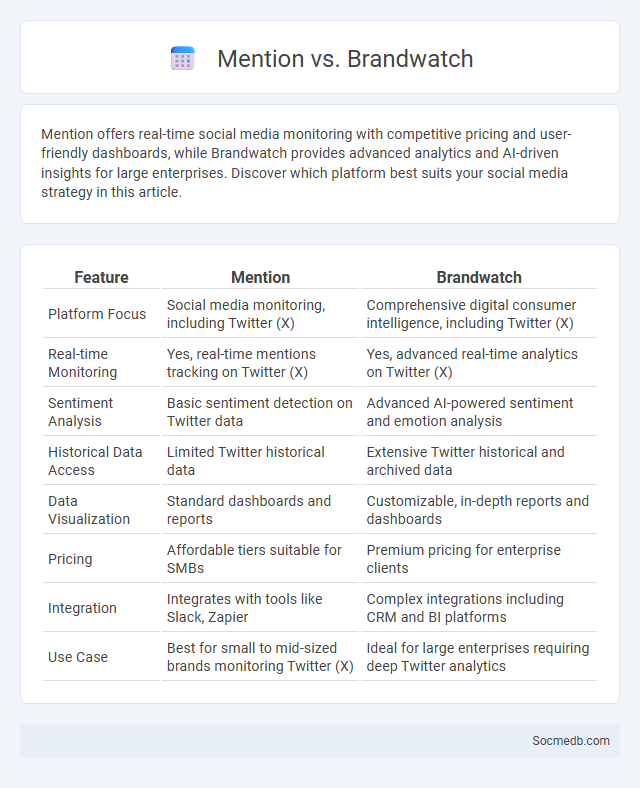
Photo illustration: Mention vs Brandwatch
Mention offers real-time social media monitoring with competitive pricing and user-friendly dashboards, while Brandwatch provides advanced analytics and AI-driven insights for large enterprises. Discover which platform best suits your social media strategy in this article.
Table of Comparison
| Feature | Mention | Brandwatch |
|---|---|---|
| Platform Focus | Social media monitoring, including Twitter (X) | Comprehensive digital consumer intelligence, including Twitter (X) |
| Real-time Monitoring | Yes, real-time mentions tracking on Twitter (X) | Yes, advanced real-time analytics on Twitter (X) |
| Sentiment Analysis | Basic sentiment detection on Twitter data | Advanced AI-powered sentiment and emotion analysis |
| Historical Data Access | Limited Twitter historical data | Extensive Twitter historical and archived data |
| Data Visualization | Standard dashboards and reports | Customizable, in-depth reports and dashboards |
| Pricing | Affordable tiers suitable for SMBs | Premium pricing for enterprise clients |
| Integration | Integrates with tools like Slack, Zapier | Complex integrations including CRM and BI platforms |
| Use Case | Best for small to mid-sized brands monitoring Twitter (X) | Ideal for large enterprises requiring deep Twitter analytics |
Introduction to Mention, Brandwatch, and Social Listening
Mention and Brandwatch are leading social listening tools that enable brands to monitor online conversations, track brand sentiment, and analyze competitor activity effectively. Social listening leverages real-time data from platforms like Twitter, Instagram, and Facebook to provide actionable insights for reputation management and marketing strategies. These tools use advanced algorithms and AI to detect trends, customer feedback, and emerging issues, empowering businesses to make informed decisions and enhance customer engagement.
Key Features Comparison
Social media platforms differ significantly in features such as content format, user interaction, and privacy settings, impacting how users engage with the content. Instagram excels in visual storytelling with photos and videos, while Twitter focuses on real-time news and concise messaging, and Facebook offers a versatile mix of text, video, and event sharing. Understanding these key features helps you choose the platform that best aligns with your communication goals and audience engagement.
Data Coverage and Sources
Social media platforms generate vast volumes of data covering user interactions, demographic information, and content trends, providing comprehensive insights into audience behavior. Sources include user profiles, posts, comments, likes, shares, and multimedia uploads, enabling detailed analysis of engagement patterns. Leveraging this extensive data coverage, you can enhance targeted marketing strategies and optimize content performance for better reach and effectiveness.
Ease of Use and User Interface
Social media platforms offer intuitive, user-friendly interfaces designed to streamline navigation and content sharing. With minimal learning curves, these interfaces enable you to effortlessly customize your experience and engage with diverse multimedia formats. Optimized for both mobile and desktop, the design ensures seamless interaction across devices, enhancing overall usability and satisfaction.
Analytics and Reporting Capabilities
Social media analytics and reporting capabilities provide comprehensive insights into audience behavior, engagement trends, and campaign performance metrics. These tools leverage data visualization, sentiment analysis, and real-time tracking to optimize content strategy and maximize ROI. Understanding your social media analytics enables you to make data-driven decisions that enhance brand visibility and user engagement.
Integration with Other Tools
Social media platforms seamlessly integrate with customer relationship management (CRM) systems, email marketing software, and analytics tools to enhance your marketing strategies. This integration allows real-time data synchronization, improving audience targeting and engagement through personalized content delivery. Leveraging APIs and third-party connectors ensures streamlined workflows across multiple digital channels and boosts overall campaign effectiveness.
Pricing and Subscription Plans
Social media platforms offer a variety of pricing and subscription plans tailored to different user needs, ranging from free basic accounts to premium plans with enhanced features such as ad-free experiences, advanced analytics, and exclusive content. You can choose from monthly or annual billing options, with businesses often benefiting from tiered pricing that supports multiple users and advanced marketing tools. Understanding the cost structures and included benefits helps optimize your investment in social media for personal use or brand growth.
Use Cases for Businesses and Brands
Social media platforms enable businesses and brands to enhance customer engagement through targeted advertising, content marketing, and real-time interaction. Utilizing analytics tools on platforms like Facebook, Instagram, and LinkedIn allows companies to measure campaign effectiveness and optimize strategies for higher conversion rates. Influencer partnerships and user-generated content further expand brand visibility and credibility, driving sales and strengthening customer loyalty.
Pros and Cons of Mention vs Brandwatch
Mention offers real-time social media monitoring with sentiment analysis and competitive benchmarking, making it ideal for immediate brand reputation management. Brandwatch provides more in-depth analytics, historical data access, and advanced AI-driven insights, empowering Your team to make strategic marketing decisions. However, Mention's features may be limited for large-scale enterprises, while Brandwatch's higher cost and complexity could be challenging for smaller businesses.
Choosing the Best Social Listening Tool for Your Needs
Selecting the best social listening tool depends on factors such as real-time data accuracy, sentiment analysis capabilities, and integration with existing marketing platforms. Tools like Brandwatch, Sprout Social, and Hootsuite offer advanced keyword tracking and competitive analysis features essential for monitoring brand reputation and customer feedback. Evaluating user interface, pricing plans, and customer support ensures the tool aligns with your business goals and budget constraints.
 socmedb.com
socmedb.com